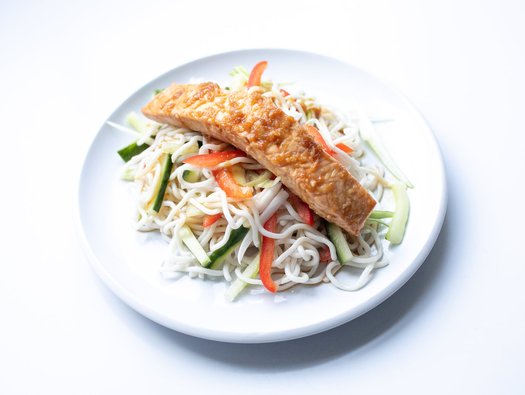Soy and ginger salmon with rice noodles

This recipe adds lots of extra flavour to the salmon without the salt!

This recipe adds lots of extra flavour to the salmon without the salt!
Juice of 1 orange
1 tablespoon low-salt soy sauce
1 clove garlic, finely grated
10g ginger, peeled and finely grated
2 salmon fillets, skin removed
275g rice noodles, straight to wok
2 spring onions, cut into thin strips
½ red pepper, deseeded and finely sliced
100g cucumber, cut into matchsticks
½ teaspoon toasted sesame oil
½ teaspoon honey
Combine the orange juice, soy sauce, garlic and ginger.
Add to a saucepan and bring to a simmer.
Reduce the heat, add the salmon and cover tightly with the saucepan lid. Cook for three minutes, turn the salmon, cover again and cook for a further three minutes until the fish is cooked through.
Meanwhile, empty the noodles into a bowl with one dessert spoon of water. Cover and microwave for one minute. Stir with a fork to separate. Add in the cucumber, pepper and spring onions, then pour over the sesame oil.
Mix the noodles and vegetables to ensure the sesame oil coats everything. Divide the mixture between two bowls and sit the salmon fillets on top.
Stir the honey into the remaining sauce in the pan and spoon over.
The main source of carbohydrate in this recipe are the noodles, values have been provided for those trained in insulin adjustment.
Rice noodles are lower in potassium and phosphate than egg noodles, helping to keep this recipe low in potassium and phosphate. The vegetables used are all lower in potassium.
Salmon is a source of phosphate so you should take your phosphate binder as prescribed if you have one.
Salmon is a good source of protein and is also classed as an oily fish. Healthy eating advice is to consume two portions of fish per week, one of which should be oily.
Frozen salmon can be cheaper than fresh but should be defrosted thoroughly before use.
Use gluten-free soy sauce.
This dish is best eaten straight away.
Kidney-friendly snacks can help you maintain a healthy weight if you're living with kidney disease. Our kidney dietitians recommend these simple options.
You can enjoy a wide variety of delicious and healthy food when you are living with kidney disease. All Kidney Kitchen recipes are analysed and approved by kidney dietitians. Search through our kidney-friendly recipes or filter them by category below.
These tasty wontons are not only a delightful addition to your meal but are also low in salt, potassium and phosphate. Plus they provide a valuable source of protein, making them a nutritious option for dialysis days.
By giving us your email address, you're giving us permission to send you the latest news from Kidney Care UK. Further information about how we protect and use your personal data is available in our Privacy policy. If you would like to change the way we communicate with you at any time please email [email protected]. You can unsubscribe at any time by using the link at the bottom of every email we send.